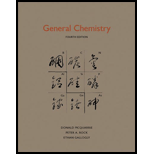
Concept explainers
(a)
Interpretation:
Complex ion
(a)
Explanation of Solution
Given complex ion is
Given complex contains
In the octahedral complex, the
Electronic configuration of iron is given as shown below;
Electronic configuration of
Therefore, there are six electrons in
Given complex is said to contain no unpaired electrons. This means all the six
(b)
Interpretation:
Complex ion
(b)
Explanation of Solution
Given complex ion is
Given complex contains
In the octahedral complex, the
Electronic configuration of iron is given as shown below;
Electronic configuration of
Therefore, there are five electrons in
Given complex is said to contain one unpaired electron. This means all the five
(c)
Interpretation:
Complex ion
(c)
Explanation of Solution
Given complex ion is
Given complex contains
In the octahedral complex, the
Electronic configuration of cobalt is given as shown below;
Electronic configuration of
Therefore, there are seven electrons in
Given complex is said to contain three unpaired electrons. This means the five
(d)
Interpretation:
Complex ion
(d)
Explanation of Solution
Given complex ion is
Given complex contains
In the octahedral complex, the
Electronic configuration of cobalt is given as shown below;
Electronic configuration of
Therefore, there are six electrons in
Given complex is said to contain four unpaired electrons. This means the four
(e)
Interpretation:
Complex ion
(e)
Explanation of Solution
Given complex ion is
Given complex contains
In the octahedral complex, the
Electronic configuration of cobalt is given as shown below;
Electronic configuration of
Therefore, there are five electrons in
Given complex is said to contain five unpaired electrons. This means all orbitals are single filled before pairing takes place and this happens in case of high-spin complex only. Therefore,
Want to see more full solutions like this?
Chapter 26 Solutions
General Chemistry
 ChemistryChemistryISBN:9781305957404Author:Steven S. Zumdahl, Susan A. Zumdahl, Donald J. DeCostePublisher:Cengage Learning
ChemistryChemistryISBN:9781305957404Author:Steven S. Zumdahl, Susan A. Zumdahl, Donald J. DeCostePublisher:Cengage Learning ChemistryChemistryISBN:9781259911156Author:Raymond Chang Dr., Jason Overby ProfessorPublisher:McGraw-Hill Education
ChemistryChemistryISBN:9781259911156Author:Raymond Chang Dr., Jason Overby ProfessorPublisher:McGraw-Hill Education Principles of Instrumental AnalysisChemistryISBN:9781305577213Author:Douglas A. Skoog, F. James Holler, Stanley R. CrouchPublisher:Cengage Learning
Principles of Instrumental AnalysisChemistryISBN:9781305577213Author:Douglas A. Skoog, F. James Holler, Stanley R. CrouchPublisher:Cengage Learning Organic ChemistryChemistryISBN:9780078021558Author:Janice Gorzynski Smith Dr.Publisher:McGraw-Hill Education
Organic ChemistryChemistryISBN:9780078021558Author:Janice Gorzynski Smith Dr.Publisher:McGraw-Hill Education Chemistry: Principles and ReactionsChemistryISBN:9781305079373Author:William L. Masterton, Cecile N. HurleyPublisher:Cengage Learning
Chemistry: Principles and ReactionsChemistryISBN:9781305079373Author:William L. Masterton, Cecile N. HurleyPublisher:Cengage Learning Elementary Principles of Chemical Processes, Bind...ChemistryISBN:9781118431221Author:Richard M. Felder, Ronald W. Rousseau, Lisa G. BullardPublisher:WILEY
Elementary Principles of Chemical Processes, Bind...ChemistryISBN:9781118431221Author:Richard M. Felder, Ronald W. Rousseau, Lisa G. BullardPublisher:WILEY





